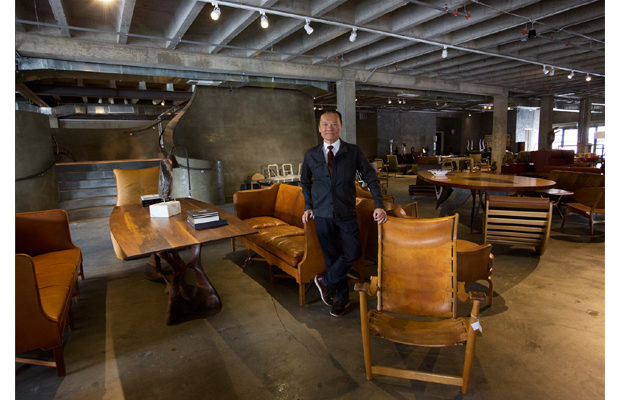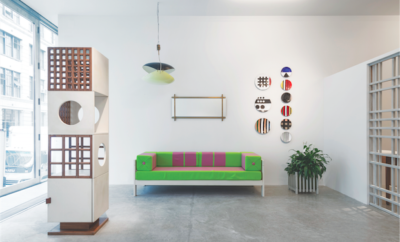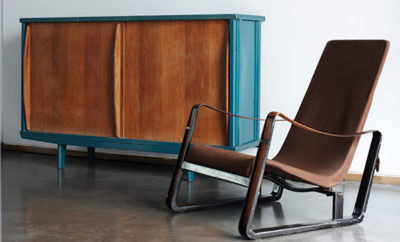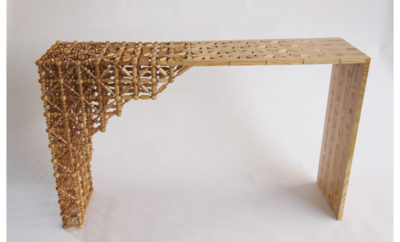
Design
L.A.’s Inimitable Treasure Trove of Design
A visit to Joel Chen’s galleries is a bit like a trip to wonderland

Joel Chen leans on Mogens Voltelen’s 1930s Copenhagen chair in his cavernous Los Angeles gallery/showroom—a favorite haunt of prominent designers and architects.
Joel Chen’s newest space on Highland Avenue in Los Angeles doesn’t have a sign, a building number, or even a clear portal, yet there’s a steady stream of prominent designers, architects, and production designers inside, perusing the ever-changing and exquisite array of antiques and twentieth-century furniture carefully curated by Chen.
You can’t help being more than a little intimated by the sheer volume, not to mention the incredible coolness, of what’s on view. The huge space is organized into small vignettes designed by Chen to enhance your appreciation of each piece. An antique Chinese screen is placed near a stunning settee inspired by Armand Rateau intricately crafted of bronze fish and shells. An exquisite red leather and oak Frits Henningsen High Back easy chair invites you to sit and study the weirdly cool Spider table by Michael Wilson. But you can’t because there is so much more to see.

Chen’s daughter’s Chihuahuas Cashew and Chestnut share one of a set of Poul Kjaerholm PK 27 chairs around Kjaerholm’s PK 66 table.
Ever patient, Chen lets you ogle your way around his shrine to modernism and beyond; and, in my case, ask questions that you know he’s answered a thousand times over the span of his thirty-eight-year career. Chen has an encyclopedic visual vocabulary that, he explains, has been acquired by traveling, reading, and meeting hundreds of artists and designers all over the world. His background in cultural anthropology accounts for his intense interest in people and the objects they create for artistic expression as well as function.
When Chen was in his twenties, a Melrose Avenue antiques dealer refused to let him into the store (perhaps, he speculates, because the owner didn’t think a young Asian man could afford anything), so he decided he would open his own shop to show how business should be done. Now he is regarded as one of the most important tastemakers in the city and is actively engaged in the global design community. In all, he has 34,000 square feet— there are actually two showrooms along Highland, just where the Hancock Park neighborhood meets West Hollywood, and a warehouse in Culver City.

Last year Chen presented White in White: Angles and Curvatures, an exhibition of exquisitely intricate contemporary ceramics by ten Korean artists.
Chen chooses things that interest him, though he admits that he’s always finding things that interest him, even though he really ought to stop acquiring. “The next thing to do is not to do,” he says. Chen credits his pragmatic wife for keeping him from going bankrupt over the years. These days it takes a bit more to get him excited, but he continues to embrace new materials and new designs. Each item is chosen for its quality, fine craftsmanship, and, most importantly, great design.
Fortunately, designers representing Hollywood’s A-list happily purchase huge containers full of furnishings on a regular basis, allowing Chen space to edit and continually rearrange the showroom vignettes to provide interest and context for all the pieces on view. Chen doesn’t like to name-drop, but every now and then he’ll share an anecdote (but we won’t, since we promised to honor his discretion.
Chen also periodically assembles individual and group shows for the artists he represents. In 2013 he presented Rapt, featuring the work of Clare Graham, a Los Angeles artist who creates art from recycled items and who now has a solo exhibition that has attracted national attention at the city’s Craft and Folk Art Museum (through January 2015). Chen had first hired Graham, an art director at Disney for twenty-five years, and his partner, former television art director Bob Breen, to create the installation for Collecting Eames, Chen’s 450-piece show of Eames furniture for Pacific Standard Time, the series of thematically linked exhibitions examining Southern California’s pivotal role in the history of art and architecture that opened in 2011. More recently, Chen presented White in White: Angles and Curvatures, featuring exquisitely intricate contemporary ceramics by ten Korean artists, graduates of the Visual Art Institute at the College of Fine Arts, Seoul National University.

Chen met Wimberley, Texas, furniture maker Michael Wilson while visiting in Austin. He’s shown here with Wilson’s weirdly cool Spider table.
Pointing to one piece with perfect thin lines of color, Chen explains, “the color is not applied, it is created by painstakingly layering in.” Employing the technique of sanggam, which means “inlay work,” the artist Jung Hong Park inserts the color using a diamond blade coated with thick layers of pigment.
When he hosts dinners for the contemporary art and design crowd, both in his showrooms and in his nearby Hancock Park house, which is itself a compendium of his wide-ranging interests in art and design, Chen arranges and coordinates people as he does art. Recently he hosted a dinner for DA2, the acquisitions committee for the Los Angeles County Art Museum’s prestigious Decorative Arts Council and another for Jeffrey Deitch shortly after he announced his departure from LA’s Museum of Contemporary Art. Chen has hosted the past three DubLab fundraisers (he sits on the board of this nonprofit web radio collective devoted to positive music, arts, and culture). He even curates the music at his events.
At the moment Chen is developing an exhibition of Michael Boyd’s Plane and Plank furniture for March 2015. A landscape, furniture, and architectural designer based in Los Angeles and San Francisco, Boyd is also a noted preservationist of modern architecture and lives in the late Oscar Niemeyer’s 1964 Strick House in Santa Monica. Boyd’s designs appeal to Chen’s aesthetic, like so much of what one sees in a tour of his showrooms. It is all elegant, functional, and a bit unexpected.
Photos by Nancy Baron












